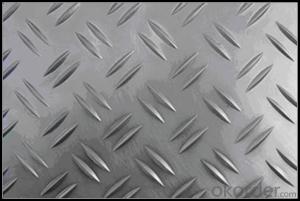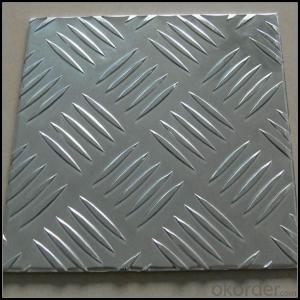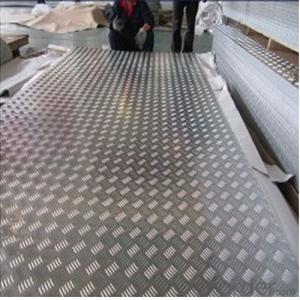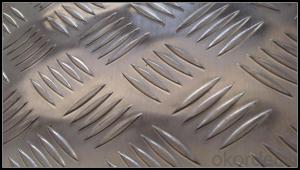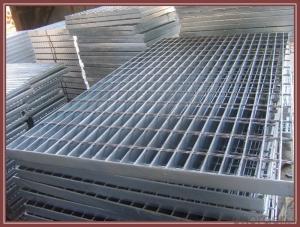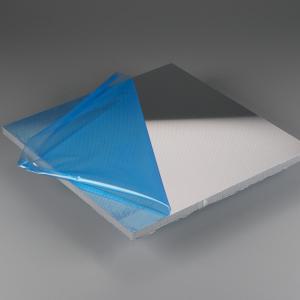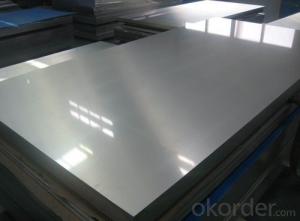Diamond Plate Sheets Aluminum - Five Bar Safety Aluminium Tread Plates 5052 HO for Toolbox
- Loading Port:
- Shanghai
- Payment Terms:
- TT OR LC
- Min Order Qty:
- 5 m.t.
- Supply Capability:
- 1000 m.t./month
OKorder Service Pledge
OKorder Financial Service
You Might Also Like
Specification
Five Bar Safety Aluminium Tread Plates 5052 HO for Toolbox
1.Structure of Five Bar Safety Aluminium Tread Plates 5052 HO for Toolbox
Aluminum Sheets are strengthened and cut from raw materials with different alloys, such as AA5005, AA5052, etc. They are easy for processing in different shapes, good in intensity and can be quickly installed. Aluminium Sheets for Energy Saving Curtain Walls are good in energy saving, weather resistance, fire resistance, easy for maintenance and with many colors.
Aluminium Sheets for Energy Saving Curtain Walls are widely used in construction of metal walls, metal ceilings, car decoration, advertizing panels, etc.
2.Main Features of Five Bar Safety Aluminium Tread Plates 5052 HO for Toolbox
•High intensity
•Easy to be processed and shaped
•Weather resistance
•Anti-pollution & environment protection
3. Five Bar Safety Aluminium Tread Plates 5052 HO for Toolbox Images
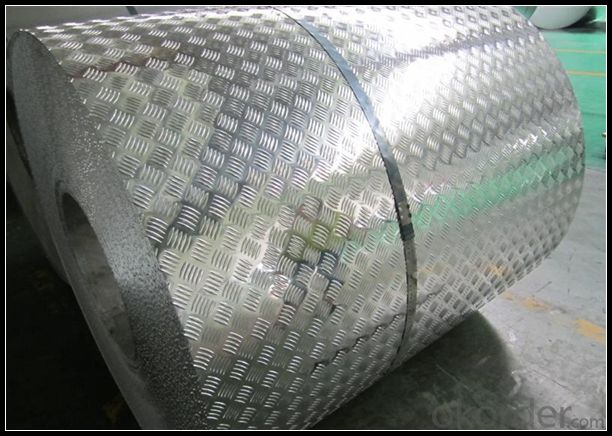

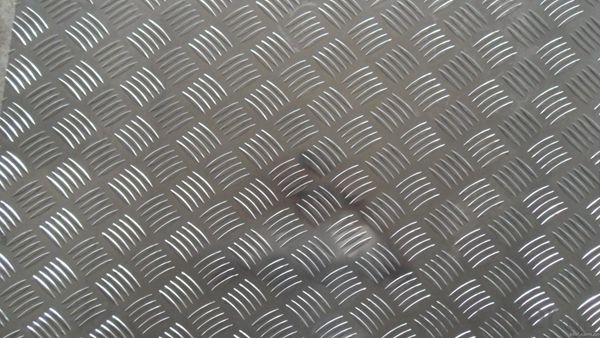
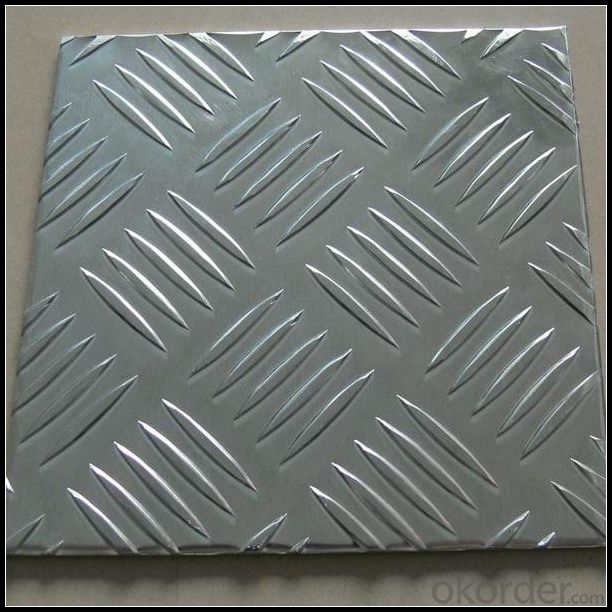
4.Specification of Five Bar Safety Aluminium Tread Plates 5052 HO for Toolbox
Alloy Number | AA5XXX |
Temper | H12, H14, H16, H18, H22, H24, H26, H32, HO, F |
Thickness | 0.1mm – 500mm |
Width | 10mm- 2200mm |
Standard | GB/T3880-2006, ASTM, ISO, EU standard |
5.FAQ of Five Bar Safety Aluminium Tread Plates 5052 HO for Toolbox
1) What is the delivery time?
Dpends on actual order, around 20 to 35 days
2)What is the QC system:
We have QC staff of 20 persons and advanced equipment, each production is with MTC traced from Aluminum ingot lot.
3) What market do you mainly sell to?
Australia, America, Asia, Middle East, Western Europe, Africa etc
- Q: What are the safety precautions when working with aluminum sheets?
- To ensure your well-being while working with aluminum sheets, it is crucial to adhere to certain safety measures. Here are some important guidelines to consider: 1. Personal Protective Equipment (PPE): Safeguard yourself from potential hazards by consistently wearing appropriate PPE, such as safety goggles, gloves, and a face mask. Aluminum sheets can cause injury if they come into contact with your eyes, skin, or respiratory system due to sharp edges, metal filings, or dust particles. 2. Ventilation: Minimize the accumulation of aluminum dust or fumes by ensuring proper ventilation in your work area. This is particularly important when cutting or shaping aluminum sheets to prevent inhaling harmful airborne particles. 3. Handling and storage: Handle aluminum sheets with care to prevent injuries, as they may have sharp edges. It is essential to wear gloves while handling them. Additionally, store the sheets securely and in an organized manner to avoid accidents like tripping or falling. 4. Cutting and shaping: Utilize appropriate tools specifically designed for cutting or shaping aluminum sheets. Refrain from using tools unsuitable for aluminum, as they can cause damage or create unsafe conditions. Make sure the cutting area is free of clutter and maintain awareness of your body position to prevent accidents. 5. Fire safety: Exercise caution regarding fire hazards since aluminum is highly flammable. Keep flammable materials away from your work area and avoid using open flames or sparks nearby. Be prepared for a fire by having a readily accessible fire extinguisher and knowing how to use it effectively. 6. Training and knowledge: Acquire proper training and knowledge concerning working with aluminum sheets. Understanding the properties of aluminum, appropriate techniques, and safety precautions can effectively prevent accidents and injuries. 7. Regular maintenance: Maintain your tools and equipment in good working condition. Regularly inspect them for any damage or signs of wear and tear, and promptly replace or repair as necessary. Faulty or poorly maintained tools can increase the risk of accidents when working with aluminum sheets. By adhering to these safety precautions, you can minimize potential risks and ensure a safe working environment when handling aluminum sheets.
- Q: What is the tensile strength of aluminum sheets?
- The tensile strength of aluminum sheets may differ based on the specific alloy and temper of the material. On average, aluminum sheets generally exhibit a tensile strength between 10,000 and 45,000 pounds per square inch (psi). It should be noted that the tensile strength of aluminum sheets varies depending on the grade and thickness. Moreover, factors like heat treatment, processing, and alloy composition can influence the tensile strength of aluminum sheets. Hence, consulting the manufacturer's specifications or conducting specific tests becomes necessary to ascertain the exact tensile strength of a particular aluminum sheet.
- Q: Could copper wire be welded with aluminum sheet?
- Copper wire could be welded with aluminum sheet, and it needs to use low temperature welding method, if copper wire is in the unit of millimeter and aluminum sheet is also in the unit below 1 mm, you can use electric soldering iron to heat it as hybrid welding and choose low temperature welding materials, you can use WEWELDING M51 welding wire and M51-F flux to complete welding. As for the large aluminum sheet, you can take liquefied gas multihole lance as heat source, then choose the same low temperature materials as welding materials, you can use WEWELDING M51 welding wire and M51-F flux to complete welding. Welding fundamentals of these two welding methods: both of them are use heatable heat source to heat the matrix to 179 degree, the melting point of WEWELDING M51, then use matrix’s heat conduction to melt welding wire, completing welding. The process of melting welding wire is the process of smearing the welding wire with flux into welding area, melting welding wire completely depends on matrix’s heat conduction.
- Q: This question asks about the various types of aluminum sheets that are suitable for use in exterior applications, specifically those that can withstand outdoor conditions.
- <p>Aluminum sheets used for exterior applications come in various types, each with specific properties to withstand weather and environmental conditions. These include: 1. Mill Finish Aluminum Sheets: These have a natural aluminum finish and are used for applications requiring a raw, industrial look. 2. Anodized Aluminum Sheets: These are aluminum sheets that have been treated to increase their resistance to corrosion and wear. 3. Painted Aluminum Sheets: These are coated with a layer of paint for added protection and aesthetic appeal. 4. Embossed Aluminum Sheets: These have a textured surface and are used for decorative purposes or to provide a non-slip surface. 5. Perforated Aluminum Sheets: These are aluminum sheets with holes punched through them, used for ventilation or decorative purposes. Each type is chosen based on the specific requirements of the exterior application, such as durability, aesthetics, and environmental resistance.</p>
- Q: How is aluminum obtained from its ore?
- Bayer's process is utilized to extract aluminum from its ore. The ore, referred to as bauxite, is initially crushed and combined with a heated solution of sodium hydroxide. This chemical reaction causes the aluminum oxide in the ore to dissolve, creating sodium aluminate. The impurities in the ore, like iron oxide and silica, remain insoluble. Afterwards, the solution undergoes filtration to eliminate the insoluble impurities, leaving a transparent liquid containing sodium aluminate. This liquid is subsequently cooled and exposed to carbon dioxide gas, which transforms the sodium aluminate into aluminum hydroxide. The aluminum hydroxide is then subjected to heat in order to produce alumina or aluminum oxide. This heating process, known as calcination, entails raising the temperature of the aluminum hydroxide to eliminate any remaining water and impurities. Lastly, the alumina is combined with a molten cryolite, functioning as a solvent, and then subjected to electrolysis. Electrolysis involves passing an electric current through the molten mixture, causing the migration of aluminum ions to the cathode, where they are reduced to form molten aluminum metal. The molten aluminum is subsequently collected and cooled, resulting in its solidification into ingots or other desired shapes. In conclusion, the extraction of aluminum from its ore involves the initial extraction of aluminum oxide using sodium hydroxide, followed by purification and conversion into alumina through calcination. The alumina is then subjected to electrolysis using a molten cryolite, leading to the production of molten aluminum metal.
- Q: What are the different types of alloys used for anodized aluminum sheets?
- Anodized aluminum sheets can be made using various types of alloys, each with its own unique characteristics and uses. Some commonly used alloys include: 1. Pure aluminum, found in 1000 series alloys, is highly resistant to corrosion. It is frequently employed in anodized aluminum sheets across different industries such as architecture, automotive, and aerospace. 2. The 5000 series alloys, which contain magnesium as the primary alloying element, offer increased strength and excellent weldability. These alloys are often chosen for anodized aluminum sheets in applications that require high strength and resistance to atmospheric corrosion. 3. The 6000 series alloys are renowned for their exceptional combination of strength, extrudability, and corrosion resistance. Among this series, the 6061 alloy is widely used for anodized aluminum sheets in structural components, marine applications, and consumer electronics. 4. The 7000 series alloys are famous for their extraordinary strength and are typically used in applications that demand high-performance materials. The most commonly utilized alloy in this series for anodized aluminum sheets is 7075, which finds extensive use in the aerospace and defense industries. 5. The 2000 series alloys are mainly employed when high strength and excellent fatigue resistance are needed. These alloys are commonly used in the aerospace industry for anodized aluminum sheets. It is crucial to consider the specific requirements of the application, including desired strength, corrosion resistance, and other mechanical properties, when selecting the appropriate alloy for anodized aluminum sheets.
- Q: Hey I just noticed that my deodorant/antiperspirant has aluminum in it. I remember reading that this is bad for you. My question is, will this be dangerous for my health in the long run?
- Deodorants do not contain aluminum, only antiperspirants do. The aluminum is used to stop sweating from occurring. There are natural antiperspirants (example Tom's of Main) that claim to stop sweat without the use of aluminum. Aluminum based products have been associated with quite a few health problems: Seizures Breast Cancer Alzheimer's Disease Bone Formation Disorders Kidney Problems Hope this helps.
- Q: Can aluminum sheets handle high temperatures?
- Certainly! High temperatures are well-tolerated by aluminum sheets. With a melting point of 660 degrees Celsius (1220 degrees Fahrenheit), aluminum proves itself suitable for various applications requiring elevated temperatures. Furthermore, aluminum possesses exceptional thermal conductivity, enabling rapid heat dissipation. This attribute renders aluminum sheets ideal for deployment in environments necessitating resistance against high temperatures, including engine components, heat exchangers, and oven linings. Nevertheless, it is crucial to take into account the specific alloy and thickness of the aluminum sheet, as different alloys may impose different temperature thresholds.
- Q: Can the aluminum sheets be used in food or beverage processing industries?
- Indeed, the food and beverage processing industries can utilize aluminum sheets. This non-toxic material is extensively employed in this field owing to its exceptional characteristics. Aluminum sheets boast corrosion resistance, light weight, and commendable thermal conductivity. These attributes render them perfect for a multitude of applications in the food and beverage processing industries, including food packaging, cooking utensils, storage containers, and beverage cans. Furthermore, aluminum proves to be an environmentally friendly choice as it is recyclable, thus amplifying its appropriateness for deployment in these sectors.
- Q: I have some carbon arrows for my bow but I was wondering if aluminum arrows penetrate farther into a deer because they weigh more. I read somewhere that they do but I just wanted to confirm that.
- Depends on what you're planning on doing with them really. But definitely no on the fiberglass. Long distance shots (50m), definitely carbon. Certain carbons do last longer, I shoot Carbon Express Nano XR, built like a tank, no aluminum comes close to the durability. Before this, I've shot ACE, built for speed and breaks left and right. So, moral of the story is, carbon's durability depends on make and model. Sadly, I have to disagree with DumDum this time around about the carbon's rigidity. For a given shaft weight, the carbon shaft will bend less than aluminums. However, for a given bow/archer setup, you need carbon shafts that bends as much as aluminum for that same setup. The basis of bow tuning is this requirement that the arrow need to bend a certain amount during the shot. Take away the bending and the arrow won't fly straight, hence the archer's paradox. Given a well tuned setup, the only variables to penetration is the KE, and the surface friction as the arrow enters the target.
Send your message to us
Diamond Plate Sheets Aluminum - Five Bar Safety Aluminium Tread Plates 5052 HO for Toolbox
- Loading Port:
- Shanghai
- Payment Terms:
- TT OR LC
- Min Order Qty:
- 5 m.t.
- Supply Capability:
- 1000 m.t./month
OKorder Service Pledge
OKorder Financial Service
Similar products
Hot products
Hot Searches
Related keywords













